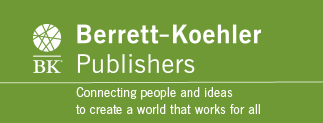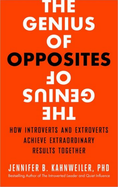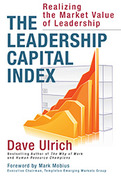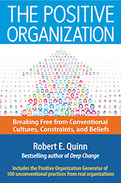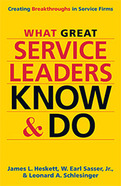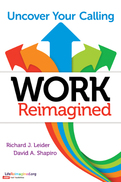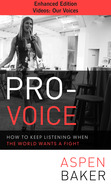Search Results: ""
Results 769-774 of 1358
Better Together
FDR and Eleanor. Mick and Keith. Jobs and Woz. There are countless examples of introvert-extrovert partnerships who make brilliant products, create great works of art, and even change history together. But these partnerships don't just happen. They demand wise nurturing.
The key, says bestselling author Jennifer Kahnweiler, is for opposites to stop emphasizing their differences and use approaches that focus them both on moving toward results. Kahnweiler's first-of-its-kind practical five-step process helps introverts and extroverts understand and appreciate each other's wiring, use conflicts to spur creativity, enrich their own skills by learning from the other, and see and act on things neither would have separately. Kahnweiler shows how to perform the delicate balancing act required to create a whole that is exponentially greater than the sum of its parts.
FDR and Eleanor. Mick and Keith. Jobs and Woz. There are countless examples of introvert-extrovert partnerships who make brilliant products, create great works of art, and even change history together. But these partnerships don't just happen. They demand wise nurturing.
The key, says bestselling author Jennifer Kahnweiler, is for opposites to stop emphasizing their differences and use approaches that focus them both on moving toward results. Kahnweiler's first-of-its-kind practical five-step process helps introverts and extroverts understand and appreciate each other's wiring, use conflicts to spur creativity, enrich their own skills by learning from the other, and see and act on things neither would have separately. Kahnweiler shows how to perform the delicate balancing act required to create a whole that is exponentially greater than the sum of its parts.
When it comes to evaluating a firm, leadership matters.
We know that financial outcomes can predict about 50 percent of a firm's market value. Intangibles like strategy, brand, talent, R&D, innovation, risk, and so on account for the rest. But leadership underlies them all. And despite how important we know it is, we've been forced to rely on subjective and unreliable ways to measure its impact—until now.
In this landmark book, leadership scholar, author, and consultant Dave Ulrich proposes a “leadership capital index”—a Moody's or Standard and Poor's rating for leadership. Drawing on research from investors and business leaders, and synthesizing the work of dozens of consulting firms and leadership experts, Ulrich analyzes two broad domains, each comprising five factors. The individual domain includes personal qualities, strategic prowess, execution proficiency, interpersonal skills, and fit between the leader's style and the organization's market promises. The organizational domain encompasses a leader's ability to create customer-focused cultures, manage talent, demand accountability, use information to gain competitive advantage, and set up work processes to deal with change.
Ulrich details rigorous metrics and methods for evaluating leaders on each of these factors. The result is a groundbreaking book that will be of vital interest not only to equity and debt investors but also to boards of directors, executive teams, human resource and leadership development professionals, government and ratings agencies—and of course to leaders themselves.
We know that financial outcomes can predict about 50 percent of a firm's market value. Intangibles like strategy, brand, talent, R&D, innovation, risk, and so on account for the rest. But leadership underlies them all. And despite how important we know it is, we've been forced to rely on subjective and unreliable ways to measure its impact—until now.
In this landmark book, leadership scholar, author, and consultant Dave Ulrich proposes a “leadership capital index”—a Moody's or Standard and Poor's rating for leadership. Drawing on research from investors and business leaders, and synthesizing the work of dozens of consulting firms and leadership experts, Ulrich analyzes two broad domains, each comprising five factors. The individual domain includes personal qualities, strategic prowess, execution proficiency, interpersonal skills, and fit between the leader's style and the organization's market promises. The organizational domain encompasses a leader's ability to create customer-focused cultures, manage talent, demand accountability, use information to gain competitive advantage, and set up work processes to deal with change.
Ulrich details rigorous metrics and methods for evaluating leaders on each of these factors. The result is a groundbreaking book that will be of vital interest not only to equity and debt investors but also to boards of directors, executive teams, human resource and leadership development professionals, government and ratings agencies—and of course to leaders themselves.
Beholden to accepted assumptions about people and organizations, too many enterprises waste human potential. Robert Quinn shows how to defy convention and create organizations where people feel fully engaged and continually rewarded, where both individually and collectively they flourish and exceed expectations.
The problem is that leaders are following a negative and constraining “mental map” that insists organizations must be rigid, top-down hierarchies and that the people in them are driven mainly by self-interest and fear. But leaders can adopt a different mental map, one where organizations are networks of fluid, evolving relationships and where people are motivated by a desire to grow, learn, and serve a larger goal. Using dozens of memorable stories, Quinn describes specific actions leaders can take to facilitate the emergence of this organizational culture—helping people gain a sense of purpose, engage in authentic conversations, see new possibilities, and sacrifice for the common good.
The book includes the Positive Organization Generator, a tool that provides 100 real-life practices from positive organizations and helps you reinvent them to fit your specific needs. With the POG you can identify and implement the practices that will have the greatest impact on your organization.
At its heart, the book helps leaders to see new possibilities that lie within the acknowledged realities of organizational life. It provides five keys for learning to be "bilingual"--speaking the conventional language of business as well as the language of the positive organization. When leaders can do this, they are able to make real and lasting change.
The problem is that leaders are following a negative and constraining “mental map” that insists organizations must be rigid, top-down hierarchies and that the people in them are driven mainly by self-interest and fear. But leaders can adopt a different mental map, one where organizations are networks of fluid, evolving relationships and where people are motivated by a desire to grow, learn, and serve a larger goal. Using dozens of memorable stories, Quinn describes specific actions leaders can take to facilitate the emergence of this organizational culture—helping people gain a sense of purpose, engage in authentic conversations, see new possibilities, and sacrifice for the common good.
The book includes the Positive Organization Generator, a tool that provides 100 real-life practices from positive organizations and helps you reinvent them to fit your specific needs. With the POG you can identify and implement the practices that will have the greatest impact on your organization.
At its heart, the book helps leaders to see new possibilities that lie within the acknowledged realities of organizational life. It provides five keys for learning to be "bilingual"--speaking the conventional language of business as well as the language of the positive organization. When leaders can do this, they are able to make real and lasting change.
Entire service businesses have been built around the ideas of Heskett, Sasser, and Schlesinger, pioneers in the world of service. Now they test their ideas against the actual experiences of successful and unsuccessful practitioners, as well as against demands of the future, in a book service leaders around the world will use as a guide for years to come.
The authors cover every aspect of optimal service leadership: the best hiring, training, and workplace organization practices; the creation of operating strategies around areas such as facility design, capacity planning, queue management, and more; the use—and misuse—of technology in delivering top-level service; and practices that can transform loyal customers into “owners.”
Looking ahead, the authors describe the world of great service leaders in which “both/and” thinking replaces trade-offs. It's a world in which new ideas will be tested against the sine qua non of the “service trifecta”—wins for employees, customers, and investors. And it's a world in which the best leaders admit that they don't have the answers and create organizations that learn, innovate, “sense and respond,” operate with fluid boundaries, and seek and achieve repeated strategic success.
Using examples of dozens of companies in a wide variety of industries, such as Apollo Hospitals, Châteauform, Starbucks, Amazon, Disney, Progressive Insurance, the Dallas Mavericks, Whole Foods, IKEA, and many others, the authors present a narrative of remarkable successes, unnecessary failures, and future promise.
The authors cover every aspect of optimal service leadership: the best hiring, training, and workplace organization practices; the creation of operating strategies around areas such as facility design, capacity planning, queue management, and more; the use—and misuse—of technology in delivering top-level service; and practices that can transform loyal customers into “owners.”
Looking ahead, the authors describe the world of great service leaders in which “both/and” thinking replaces trade-offs. It's a world in which new ideas will be tested against the sine qua non of the “service trifecta”—wins for employees, customers, and investors. And it's a world in which the best leaders admit that they don't have the answers and create organizations that learn, innovate, “sense and respond,” operate with fluid boundaries, and seek and achieve repeated strategic success.
Using examples of dozens of companies in a wide variety of industries, such as Apollo Hospitals, Châteauform, Starbucks, Amazon, Disney, Progressive Insurance, the Dallas Mavericks, Whole Foods, IKEA, and many others, the authors present a narrative of remarkable successes, unnecessary failures, and future promise.
Work Reimagined
2015
DISCOVER WHAT YOU'RE HERE TO DO
It's the end of work as we know it. Career paths look nothing like they did in the days before phones got smart. We work more hours at more jobs for more years than ever before. So it's vital that we know how to find work that allows us to remain true to who we are in the deepest sense, work that connects us to something larger than ourselves—in short, our “calling.” We all have one, and bestselling authors Richard Leider and David Shapiro can help you uncover yours.
Through a unique Calling Card exercise that features a guided exploration of fifty-two “natural preferences” (such as Advancing Ideas, Doing the Numbers, Building Relationships, and Performing Events), Leider and Shapiro give us a new way to uncover our gifts, passions, and values and find work that expresses them. Along the way, they mix in dozens of inspiring true stories about people who have found, or are in the process of finding, their own callings.
Uncovering your calling enables you to experience fulfillment in all aspects and phases of your life. And here's the even better news: you'll never have to work again. When you choose to do what you are called to do, you're always doing what you want to do. Work Reimagined offers an enlightening, effective, and entertaining approach to discovering what you were born to do, no matter your age or stage of life.
It's the end of work as we know it. Career paths look nothing like they did in the days before phones got smart. We work more hours at more jobs for more years than ever before. So it's vital that we know how to find work that allows us to remain true to who we are in the deepest sense, work that connects us to something larger than ourselves—in short, our “calling.” We all have one, and bestselling authors Richard Leider and David Shapiro can help you uncover yours.
Through a unique Calling Card exercise that features a guided exploration of fifty-two “natural preferences” (such as Advancing Ideas, Doing the Numbers, Building Relationships, and Performing Events), Leider and Shapiro give us a new way to uncover our gifts, passions, and values and find work that expresses them. Along the way, they mix in dozens of inspiring true stories about people who have found, or are in the process of finding, their own callings.
Uncovering your calling enables you to experience fulfillment in all aspects and phases of your life. And here's the even better news: you'll never have to work again. When you choose to do what you are called to do, you're always doing what you want to do. Work Reimagined offers an enlightening, effective, and entertaining approach to discovering what you were born to do, no matter your age or stage of life.
Pro-Voice (Enhanced)
2015
Dialogue, Not Dogma
When Aspen Baker had an abortion at the age of twenty-four, she felt caught between the warring pro-life and pro-choice factions, with no safe space to share her feelings.
This enhanced edition includes a video of Aspen sharing her personal story, but it also includes videos of the women and men who've been profoundly changed by the movement Aspen founded. As you watch and listen, you will see how the Pro-Voice movement can be a game-changer. Through deep listening, storytelling, and embracing gray areas, the movement has generated love, empathy and support on both sides of America's most controversial issue.
In this hopeful and moving book, Baker describes how she and Exhale, the organization she cofounded, developed their “pro-voice” philosophy and the creative approaches they employed to help women and men have respectful, compassionate exchanges about even this most controversial of topics. She shows how pro-voice can be adopted by anyone interested in replacing ideological gridlock with empathetic conversation. Peace, in this perspective, isn't a world without conflict but one where conflict can be engaged in—fiercely and directly—without dehumanizing ourselves or our opponents.
When Aspen Baker had an abortion at the age of twenty-four, she felt caught between the warring pro-life and pro-choice factions, with no safe space to share her feelings.
This enhanced edition includes a video of Aspen sharing her personal story, but it also includes videos of the women and men who've been profoundly changed by the movement Aspen founded. As you watch and listen, you will see how the Pro-Voice movement can be a game-changer. Through deep listening, storytelling, and embracing gray areas, the movement has generated love, empathy and support on both sides of America's most controversial issue.
In this hopeful and moving book, Baker describes how she and Exhale, the organization she cofounded, developed their “pro-voice” philosophy and the creative approaches they employed to help women and men have respectful, compassionate exchanges about even this most controversial of topics. She shows how pro-voice can be adopted by anyone interested in replacing ideological gridlock with empathetic conversation. Peace, in this perspective, isn't a world without conflict but one where conflict can be engaged in—fiercely and directly—without dehumanizing ourselves or our opponents.
